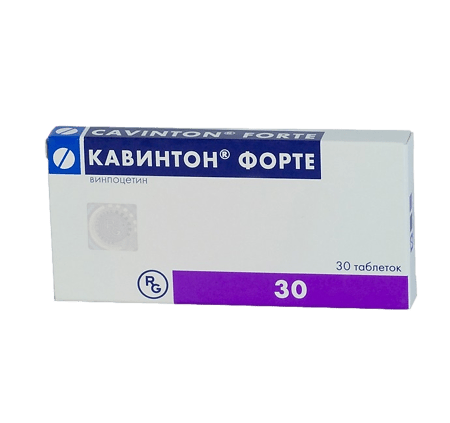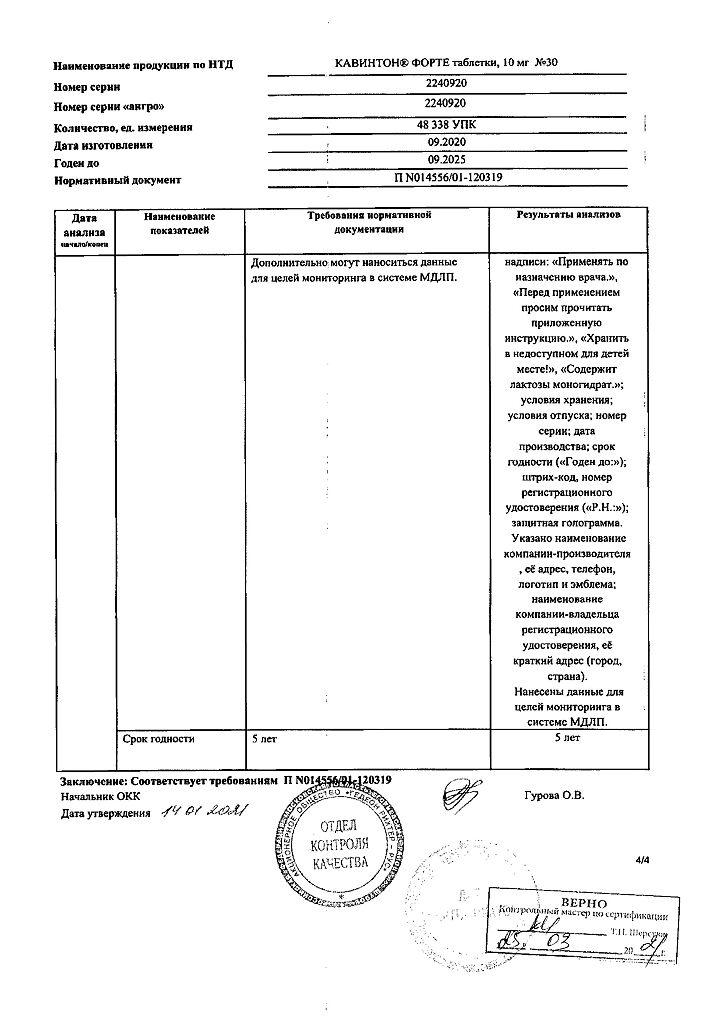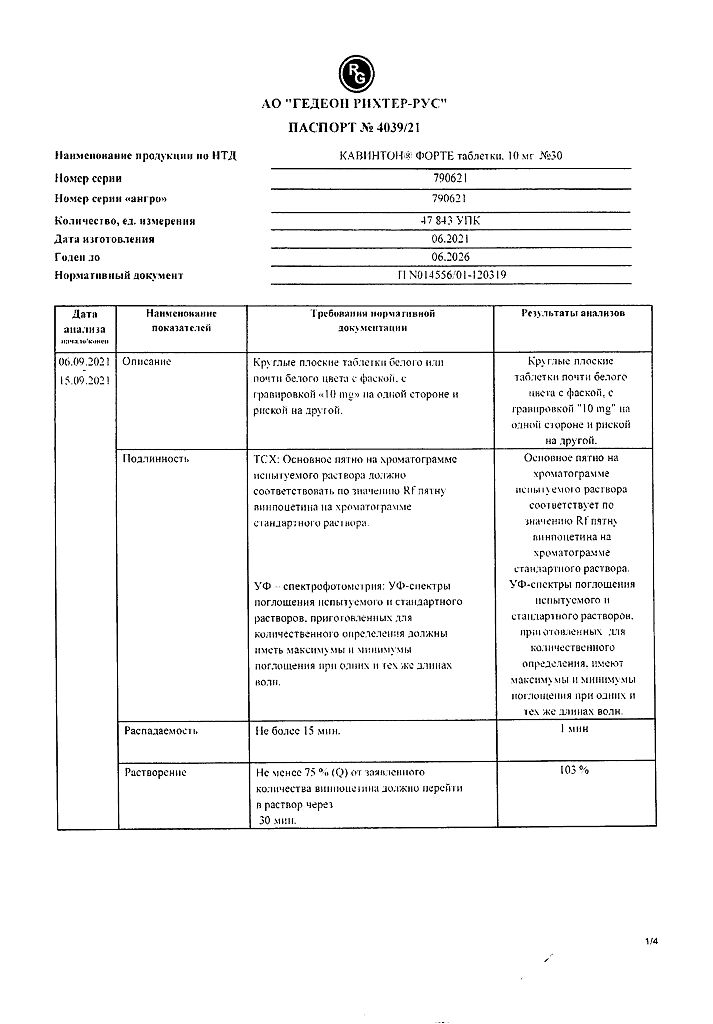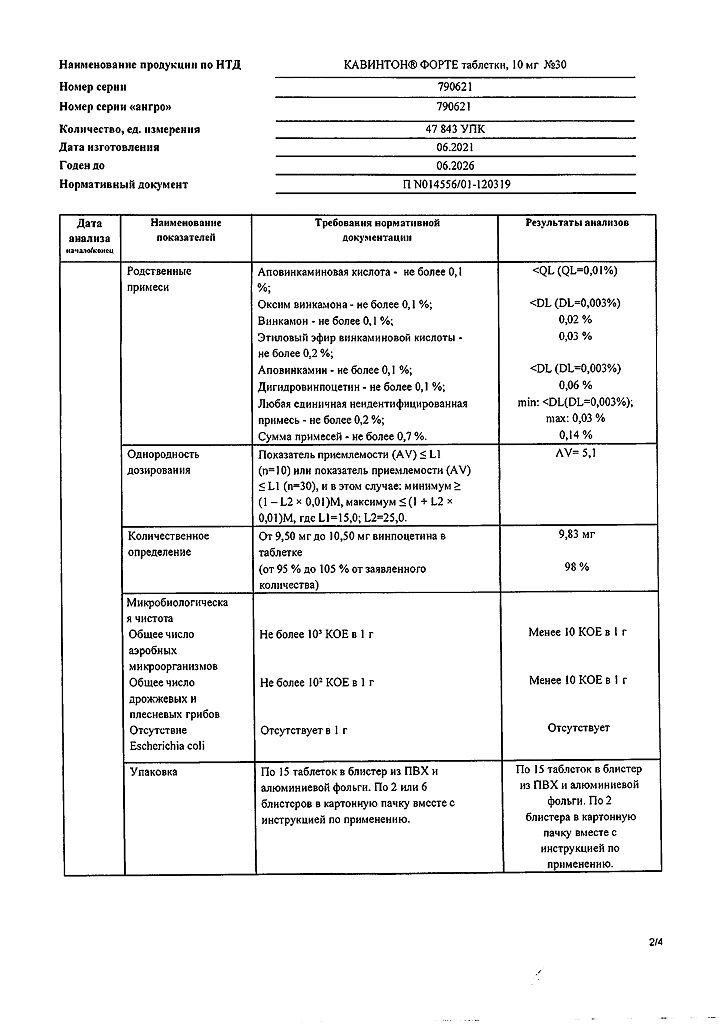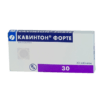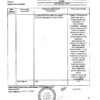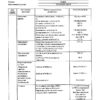No products in the cart.
Cavinton Forte, tablets 10 mg 30 pcs
€5.00 €4.97
Description
Cavinton is a drug that improves cerebral circulation, cerebral metabolism and rheological properties of the blood.
It has cerebroprotective effect. It reduces severity of damaging cytotoxic reactions caused by stimulating amino acids; it inhibits functional activity of both cellular transmembrane sodium and calcium channels and NMDA and AMPA receptors. Potentiates neuroprotective effect of adenosine.
Stimulates brain metabolism, increases absorption and assimilation of glucose and oxygen by the brain. Stimulates the transport of glucose through the GEB, shifts glucose metabolism in an energetically more favorable aerobic direction.
It selectively inhibits Ca2+-calmodulin-dependent cGMP-phosphodiesterase, increases the concentration of cAMP and cGMP in brain tissue, as well as ATP concentration and ATP/AMP ratio. It stimulates cerebral metabolism of noradrenaline and serotonin, stimulates the ascending noradrenergic system and has an antioxidant effect.
The drug selectively increases cerebral blood flow: increases cerebral fraction of minute volume; decreases resistance of cerebral vessels without affecting parameters of total blood circulation (BP, minute volume, HR, RPS).
It does not cause the phenomenon of “stealing”; on the contrary, its use primarily increases the blood supply to the ischemic, but still viable area with low perfusion – the phenomenon of “reverse stealing”.
It improves the tolerance of hypoxia by brain cells by promoting the transport of oxygen to the tissues by reducing the affinity of red blood cells for it.
The drug improves microcirculation in the brain, inhibits platelet aggregation, reduces abnormally high blood viscosity, increases the deformability of red blood cells and blocks their absorption of adenosine.
Pharmacokinetics
Therapeutic plasma concentration is 10-20 ng/ml. When parenteral administration, Vd is 5.3 l/kg. T1/2 – 4.74-5 hours. Easily penetrates through histohematic barriers (including the GEB). It is excreted by the kidneys and through the gastrointestinal tract in the ratio of 3:2.
Indications
Indications
In neurology
acute and chronic cerebral circulatory failure (transient ischemia, progressive stroke,
conditions after a stroke,
vascular dementia,
cerebral atherosclerosis,
post-traumatic and hypertensive encephalopathy,
vertebrobasilar insufficiency);
mental and neurological disorders in patients with cerebrovascular insufficiency (including memory impairment, dizziness, headache, aphasia, apraxia, movement disorders).
In ophthalmology: vascular diseases of the eyes (atherosclerosis, vasospasm of the choroid and retina, degenerative diseases of the choroid, retina or macula, arterial and venous thrombosis or embolism, secondary glaucoma).
In ENT practice
hearing loss (vascular, toxic or age-related),
Meniere’s disease
cochleovestibular neuritis,
tinnitus,
dizziness (of labyrinthine origin);
vasovegetative manifestations of menopausal syndrome.
Pharmacological effect
Pharmacological effect
Cavinton is a drug that improves cerebral circulation, cerebral metabolism and rheological properties of blood.
Has a cerebroprotective effect. Reduces the severity of damaging cytotoxic reactions caused by stimulating amino acids; inhibits the functional activity of both cellular transmembrane sodium and calcium channels, and NMDA and AMPA receptors. Potentiates the neuroprotective effect of adenosine.
Stimulates brain metabolism, enhances the absorption and assimilation of glucose and oxygen by the brain. Stimulates glucose transport across the BBB, shifts glucose metabolism to an energetically more favorable aerobic direction.
Selectively inhibits Ca2+-calmodulin-dependent cGMP phosphodiesterase, increases the concentration of cAMP and cGMP in brain tissue, as well as the concentration of ATP and the ATP/AMP ratio. Stimulates the cerebral metabolism of norepinephrine and serotonin, stimulates the ascending noradrenergic system, and has an antioxidant effect.
The drug selectively enhances cerebral blood flow: increases the cerebral fraction of minute volume; reduces cerebral vascular resistance without affecting the parameters of general circulation (blood pressure, minute volume, heart rate, peripheral resistance).
Does not cause the phenomenon of “robbing”; on the contrary, its use primarily increases the blood supply to the ischemic but still viable area with low perfusion – the phenomenon of “reverse steal”.
Improves the tolerance of hypoxia by brain cells, promoting the transport of oxygen to tissues due to a decrease in the affinity of red blood cells for it.
The drug improves brain microcirculation, inhibits platelet aggregation, reduces pathologically increased blood viscosity, increases the deformability of red blood cells and blocks their absorption of adenosine.
Pharmacokinetics
Therapeutic concentration in plasma is 10–20 ng/ml. When administered parenterally, Vd is 5.3 l/kg. T1/2 – 4.74–5 hours. Easily penetrates histohematic barriers (including the BBB). Excreted by the kidneys and through the gastrointestinal tract in a ratio of 3:2.
Special instructions
Special instructions
The presence of long QT syndrome and concomitant use of drugs that cause prolongation of the QT interval necessitate periodic ECG monitoring.
Cavinton tablets contain lactose.
Active ingredient
Active ingredient
Vinpocetine
Composition
Composition
1 tablet contains:
active ingredient:
vinpocetine 10 mg;
excipients:
colloidal silica anhydrous,
magnesium stearate,
talc,
starch,
lactose.
Pregnancy
Pregnancy
Contraindicated during pregnancy. Vinpocetine penetrates the placental barrier.
Moreover, its concentration in the placenta and fetal blood is lower than in the blood of a pregnant woman.
At high doses, placental bleeding and spontaneous abortions are possible, probably as a result of increased placental blood supply. Within an hour, 0.25% of the administered dose of the drug passes into breast milk.
When using the drug, you must stop breastfeeding.
Contraindications
Contraindications
known hypersensitivity to vinpocetine;
acute phase of hemorrhagic stroke;
severe form of coronary heart disease;
severe forms of arrhythmia;
pregnancy;
lactation period;
children under 18 years of age (due to insufficient data).
lactose intolerance.
Side Effects
Side Effects
From the cardiovascular system: it is possible to increase the manifestations of existing arrhythmia.
From the digestive system: nausea, heartburn, dry mouth.
From the central nervous system: headache, dizziness, sleep disturbance, weakness.
Allergic reactions: skin rash, urticaria.
Skin reactions: hyperemia of the skin.
Interaction
Interaction
Not observed when used simultaneously with pindolol, clopamide, glibenclamide, digoxin, acenocoumarol and hydrochlorothiazide; imipramine.
In rare cases, simultaneous use with α-methyldopa is accompanied by a slight increase in the hypotensive effect; when using this combination, regular monitoring of blood pressure is necessary.
Despite the lack of data confirming the possibility of interaction, caution is recommended when coadministered with drugs with central, antiarrhythmic and anticoagulant action.
Overdose
Overdose
Currently, data on overdose of vinpocetine are limited.
Treatment: gastric lavage, taking activated carbon, symptomatic therapy.
Storage conditions
Storage conditions
In a place protected from light, at a temperature of 15–30 °C
Shelf life
Shelf life
5 years
Manufacturer
Manufacturer
Gedeon Richter-RUS, Russia
Additional information
| Shelf life | 5 years |
|---|---|
| Conditions of storage | In a light-protected place at 15-30 °C |
| Manufacturer | Gedeon Richter Rus, Russia |
| Medication form | pills |
| Brand | Gedeon Richter Rus |
Related products
Buy Cavinton Forte, tablets 10 mg 30 pcs with delivery to USA, UK, Europe and over 120 other countries.

